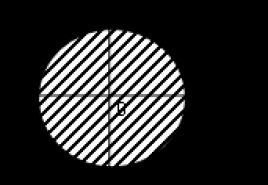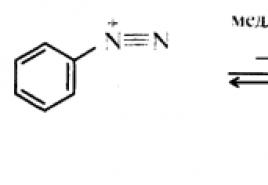Mass of a substance according to the periodic table. How to calculate the molecular and molar mass of a substance? Molar mass of elements
Molar mass is a term that is familiar to most chemistry classes, but molar mass is also found in physics and a variety of related sciences. First of all, you first need to remember what a moth is. The mole is the accepted unit of measurement for the amount of a substance. The number of particles in 1 mole is constant for any substance and is equal to Avogadro's number. Avogadro's constant is a constant value that is quite common in chemistry and has a numerical value of 6.02214179 * 10 23. In other words, we can say that a mole is an amount of a substance whose mass is equal to the numerical value of the molecular mass in grams.
Having understood the concept of a mole, let's consider the concept of the molar mass of a substance. Molar mass is the mass of 1 mole of a substance. For some elements, this mass is the mass of individual atoms of the substance. Calculating the molar mass of any substance is very simple, but we will return to this a little later. It is noteworthy that molecular weight and molar mass have the same numerical value, but have different dimensions and represent completely different physical meanings. The unit of molar mass is g/mol. This indicator tells you how many grams of a substance are contained in one mole. Molar mass is very often encountered in problems of chemistry and physics, so let’s take a closer look at how to calculate the molar mass of a substance.
How to find molar mass
The molar mass of some common substances can be found in special tables. This method, although simple, is rarely used, because calculating the molar mass of a substance manually can be easier than finding such a table. Also, the molar mass can be calculated using a special molar mass calculator. Here, for example, is the address of an online calculator that calculates the molar mass of a substance. Go to http://www.webqc.org/mmcalc.php. This calculator is completely English, but you only need to correctly write down the formula of the substance of interest. It is also not difficult to find the molecular mass of a substance and simply change the dimension. However, we will consider the simplest and most common method below. To calculate the molar mass of a substance using this method, you only need the periodic table.
In order to determine the molar mass of a substance, you need:
- First of all, you need to know the formula of your substance
- In order to determine the molar mass, you need to calculate the molar mass of the elements separately, and then sum them up.
- We select the molar mass of each specific element. We find the required atom in the periodic table, its mass is written under it.
- We look at how many atoms are in an element and simply multiply the mass by the number of atoms.
- Let's sum up the molar mass of all elements.
All! As you can see, the process of calculating the molar mass of a substance is quite simple.
Most secondary school students consider chemistry to be one of the most difficult and unpleasant subjects for them. In fact, chemistry is no more complicated than physics or mathematics, and in some cases it is much more interesting than them. Many students, having not yet started studying chemistry, are already subconsciously afraid of it, having heard plenty of reviews from high school students about all the “horrors” of this subject and the “tyranny” of its teacher.
Another reason why chemistry is difficult is that it involves some specific key concepts and terms that the student has never encountered before and for which it is difficult to find an analogy in ordinary life. Without an appropriate explanation from the teacher, these terms remain misunderstood by students, which complicates the entire subsequent process of studying chemistry.
One of these terms is the concept of the molar mass of a substance and the task of finding it. This is the basis of the fundamentals of the entire subject of chemistry.
What is the molar mass of a substance
The classic definition is that molar mass is the mass of one mole of a substance. Everything seems simple, but it remains unclear what “one moth” is and whether it has any connection with insects.
Mole- this is the amount of a substance that contains a certain number of molecules, to be precise, 6.02 ∙ 10 23. This number is called a constant or Avogadro's number.
All chemicals have different compositions and molecular sizes. Therefore, if you take one portion consisting of 6.02 ∙ 10 23 molecules, then different substances will have their own volume and mass of this portion. The mass of this portion will be the molar mass of a particular substance. Molar mass is traditionally denoted in chemistry by the letter M and has the dimensions g/mol and kg/mol.
How to find the molar mass of a substance
Before you begin calculating the molar mass of a substance, you need to clearly understand the key concepts associated with it.
- Molar mass of a substance numerically equal to relative molecular weight, if the structural units of a substance are molecules. The molar mass of a substance can also be equal to the relative atomic mass, if the structural units of a substance are atoms.
- Relative atomic mass shows how many times the mass of an atom of a particular chemical element is greater than a predetermined constant value for which the mass of 1/12 of a carbon atom is taken. The concept of relative atomic mass is introduced for convenience, since it is difficult for a person to operate with such small numbers as the mass of one atom.
- If a substance consists of ions, then in this case we talk about its relative formula mass. For example, the substance calcium carbonate CaCO 3 consists of ions.
- The relative atomic mass of a substance of a particular chemical element can be found in the periodic table. For example, for the chemical element carbon, the relative atomic mass is 12.011. Relative atomic mass has no units of measurement. The molar mass of carbon will be equal, as mentioned above, to the relative atomic mass, but at the same time it will have units of measurement. That is, the molar mass of carbon will be 12 g/mol. This means that 6.02 ∙ 10 23 carbon atoms will weigh 12 grams.
- Relative molecular mass can be found as the sum of the atomic masses of all chemical elements forming a molecule of a substance. Let's consider this using the example of carbon dioxide, or as everyone else calls it carbon dioxide, which has the formula CO 2.
A carbon dioxide molecule contains one carbon atom and two oxygen atoms. Using the periodic table, we find that the relative molecular mass of carbon dioxide will be equal to 12 + 16 ∙ 2 = 44 g/mol. This is exactly the mass that a portion of carbon dioxide will have, consisting of 6.02 ∙ 10 23 molecules.
- The classic formula for finding the molar mass of a substance in chemistry is as follows:
M = m/n
where, m is the mass of the substance, g;
n is the number of moles of a substance, that is, how many portions of 6.02 ∙ 10 23 molecules, atoms or ions it contains, moles.Accordingly, the number of moles of a substance can be determined by the formula:
n = N/Na
where, N is the total number of atoms or molecules;
N a is Avogadro’s number or constant, equal to 6.02 ∙ 10 23.Most problems in finding the molar mass of a substance in chemistry are based on these two formulas. Using two related relationships is unlikely to be an insurmountable difficulty for most people. The main thing is to understand the essence of basic concepts such as mole, molar mass and relative atomic mass, and then solving problems in chemistry will not cause you any difficulties.
To solve most typical chemistry problems, you can also add one of the known conditions: the number of molecules, the number of moles, or the mass of the substance. Below the button Calculate after clicking it, a complete solution to the problem will be given based on the entered initial data.
If there are brackets in the chemical formula of a substance, then expand them by adding the corresponding index to each element. For example, instead of the classic formula for calcium hydroxide Ca(OH) 2, use the following formula for the chemical substance CaO 2 H 2 in the calculator.
The molar mass of a substance, denoted M, is the mass that 1 mole of a certain chemical substance has. Molar mass is measured in kg/mol or g/mol.
Instructions
- To determine the molar mass of a substance, it is necessary to know its qualitative and quantitative composition. The molar mass expressed in g/mol is numerically equal to the relative molecular mass of the substance - Mr.
- Molecular mass is the mass of a molecule of a substance, expressed in atomic mass units. Molecular weight is also called molecular weight. To find the molecular mass of a molecule you need to add relative masses all the atoms that make up it.
- Relative atomic mass is the mass of an atom expressed in atomic mass units. The atomic mass unit is a common unit of measurement for atomic and molecular masses, equal to 1/12 the mass of a neutral 12C atom, the most common isotope of carbon.
- Atomic masses of all chemical elements present in earth's crust, are presented in the periodic table. By adding up the relative atomic masses of all the elements that make up a chemical substance or molecules, you will find the molecular mass of the chemical substance, which will be equal to the molar mass, expressed in g/mol.
- Also, the molar mass of a substance is equal to the ratio of the mass of the substance m (measured in kilograms or grams) to the amount of substance ν (measured in moles).
Anonymous
To do this, you need to use the periodic table. In the cell of any element a number is given, most often accurate to 3-4 decimal places - this is the relative molecular mass (molar mass) of this element. Typically, molecular weight is rounded according to the appropriate mathematical rules, with the exception of chlorine - the molecular weight of a chlorine atom is 35.5. Molecular weight complex substance equal to the sum of the molecular masses of its constituent elements. For example, water is H2O. The molecular weight of hydrogen is 1, oxygen - 16. This means that the molecular weight of water is 2 * 1 + 16 = 18 g/mol.
Anonymous
To determine the molar mass of substances it is necessary:
- have a table of the periodic system of chemical elements D.I. Mendeleev;
- know the number of atoms of each element in the formula of the substance in question;
- know the definition of the concepts “molar mass”, “mole”.
Substance formula
To describe a substance, it is necessary to know how many atoms and what type one molecule of the substance in question contains. For example, inert gas krypton exists under normal conditions (atmospheric pressure 101325 Pa = 760 mm Hg, temperature 273.15 K = 0°C) in the atomic form Kr. A carbon monoxide molecule consists of two carbon atoms C and an oxygen atom O: CO2. And the coolant of the refrigerator - freon 134 - has a more complex formula: CF3CFH2.
Definitions
Molar mass Mr is the mass of one mole of a substance, measured in g/mol.
A mole is an amount of a substance that contains a certain number of atoms of a given type. Defined as the number of atoms in 12 g of the carbon isotope C-12 and equal to Avogadro’s constant N = 6.022 * 10^23 1/mol.
Calculation of molar mass
To determine the molar mass Mr of a substance, it is necessary to find out the atomic mass Ar of each element included in the substance, using the table of the periodic system of chemical elements by D.I. Mendeleev, and know the number of atoms of each element.
For example, the molar mass Mr of sodium tetraborate Na2B4O7 * 10 H2O is:
M r (Na2B4O7 * 10 H2O) = 2 * Ar (Na) + 4 * Ar (B) + 7 * Ar (O) + 10* 2 * Ar (H) + 10 * Ar (O) = 2 * 23 + 4 * 11 + 7 * 16 + 10* 2 * 1 * 16 = 223 g/mol.
Instructions
To find a mole of a substance, you need to remember a very simple rule: the mass of one mole of any substance is numerically equal to its molecular mass, only expressed in other quantities. How is it determined? Using the periodic table, you will find out the atomic mass of each element included in the molecules of a substance. Next, you need to add up the atomic masses, taking into account the index of each element, and you will get the answer.
Calculate its molecular weight taking into account the index of each element: 12*2 + 1*4 + 16*3 = 76 amu. (atomic mass units). Therefore, its molar mass (that is, the mass of one mole) is also 76, only its dimension is grams/mol. Answer: one mole of ammonium nitrate weighs 76 grams.
Suppose you are given such a task. It is known that the mass of 179.2 liters of some gas is 352 grams. It is necessary to determine how much one mole of this gas weighs. It is known that under normal conditions one mole of any gas or mixture of gases occupies a volume approximately equal to 22.4 liters. And you have 179.2 liters. Do the calculation: 179.2/22.4 = 8. Therefore, this volume contains 8 moles of gas.
Dividing the mass known according to the conditions of the problem by the number of moles, you get: 352/8 = 44. Therefore, one mole of this gas weighs 44 grams - this is carbon dioxide, CO2.
If there is a certain amount of gas of mass M, enclosed in a volume V at a given temperature T and pressure P. It is required to determine its molar mass (that is, find what its mole is equal to). The universal Mendeleev-Clapeyron equation will help you solve the problem: PV = MRT/m, where m is the very molar mass that we need to determine, and R is the universal gas constant equal to 8.31. Transforming the equation, you get: m = MRT/PV. By substituting known quantities into the formula, you will find what a mole of gas is equal to.
Calculations usually use rounded values for the atomic weights of elements. If higher precision is required, rounding is not acceptable.
A. Avogadro in 1811, at the very beginning of the development of atomic theory, made the assumption that in equal amount Ideal gases contain the same number of molecules at the same pressure and temperature. Later this assumption was confirmed and became a necessary consequence for kinetic theory. Now this theory is called Avogadro.
Instructions
Avogadro's constant shows the number of atoms or molecules that are contained in one mole of a substance.
The number of molecules, provided that the system is one-component and the molecules or atoms of the same type contained in it, can be found using a special formula
Video on the topic
First define chemical composition And physical state substances. If you are testing a gas, measure its temperature, volume, and pressure, or place it under normal conditions and measure only the volume. After this, calculate the number of molecules and atoms. To determine the number of atoms in a solid or liquid, find its mass and molar mass, and then the number of molecules and atoms.

You will need
- pressure gauge, thermometer, scales and periodic table, find out Avogadro's constant.
Instructions
Determining the mass of one mole from a known amount of a substance If the amount of a substance in moles is known, the molar mass of which needs to be found, use a scale to find its actual mass, expressing it in grams. To determine the mass of one mole, divide the mass of the substance by its amount M=m/υ.
Determining the mass of one mole of a substance by the mass of a molecule If the mass of one molecule of a substance, expressed in grams, is known, find the mass of one mole by multiplying the mass of this molecule by the number of molecules in one mole (Avogadro's number), which is equal to 6.022 10^23, M = m0 NA .
Determining the mass of one mole of gas Take a sealed vessel of known volume, expressed in cubic meters. Pump out the gas from it and weigh it on a scale. Pump gas into it and weigh it again, the difference between the empty and filled cylinders will be equal to the mass of the gas. Convert it to kilograms.
Measure the temperature of the gas in the cylinder; if you wait a little after pumping, it will become equal to the ambient air temperature, and convert it to kelvins by adding the number 273 to degrees Celsius. Measure the gas pressure with a pressure gauge, in pascals. Find the molar mass of a gas (mass of one mole) by multiplying the mass of the gas by its temperature and 8.31 (the universal gas constant), and dividing the result by the pressure and volume M=m R T/(P V).
Sometimes researchers are faced with the following problem: how to determine the number of atoms of a particular substance? Initially, it may seem extremely complex, because the number of atoms even in a tiny sample of any substance is simply enormous. How to count them?

Instructions
Suppose you need to count the number of atoms in a piece of pure copper, for example, or even gold. Yes, imagine yourself in the place of the great scientist Archimedes, to whom King Hiero gave a completely different assignment, saying: “You know, Archimedes, in vain I suspected my jeweler of fraud, the crown turned out to be made of pure gold! Our royal majesty now wants to know the atoms in it.”
The task, naturally, would have plunged the real Archimedes into a stupor, even though he was. Well, you could deal with it in no time. First you need to accurately weigh the crown. Suppose it weighed exactly 2 kg, that is, 2000 grams. Then, using the periodic table, set the molar mass of gold (approximately 197 grams/mol.) To simplify the calculations, round up a little - let it be 200 grams/mol. Therefore, there are exactly 10 moles of gold in the ill-fated crown. Well, then take Avogadro’s universal number (6.022x1023), multiply by 10 and triumphantly take the result to King Hieron.
And then use the well-known Mendeleev–Clapeyron equation: PV = MRT/m. Note that M/m is nothing more than the number of moles of a given gas, since M is its actual mass and m is its molar mass.
Substitute the values you know into the fraction PV/RT, multiply the result found by Avogadro’s universal number (6.022*1023) and get the number of gas atoms at a given volume, pressure and temperature.
What if you need to count the number of atoms in a sample of a complex substance? And there is nothing particularly difficult here. Weigh the sample, then write its exact chemical formula, use the Periodic Table to clarify the molar mass of each component and calculate the exact molar mass of this complex substance (taking into account the elemental indices if necessary).
Well, then find out the number of moles in the sample under study (by dividing the mass of the sample by the molar mass) and multiply the result by the value of Avogadro’s number.
In chemistry, the mole is used as a unit of quantity of a substance. A substance has three characteristics: mass, molar mass, and amount of substance. Molar mass is the mass of one mole of a substance.

Instructions
One mole of a substance represents its quantity, which contains as many structural units as there are atoms contained in 0.012 kg of an ordinary (non-radioactive) isotope. The structural units of matter are molecules, atoms, ions. When the conditions of the problem are given with the relative atomic mass of Ar, from the formula of the substance, depending on the formulation of the problem, either the mass of one mole of the same substance or its molar mass is found by performing calculations. The relative atomic mass of Ar is the quantity equal to the ratio the average mass of an isotope of an element to 1/12 the mass of carbon.
Both organic and inorganic substances. For example, calculate this parameter in relation to water H2O and methane CH3. First find the molar mass of water:
M(H2O)=2Ar(H)+Ar(O)=2*1+16=18 g/mol
Methane is a gas of organic origin. This means that its molecule contains hydrogen and carbon atoms. Just one molecule of this gas contains three hydrogen atoms and one carbon atom. Calculate the molar mass of this substance as follows:
M(CH3)=Ar(C)+2Ar(H)=12+3*1=15 g/mol
Calculate the molar masses of any other substances in the same way.
Also, the mass of one mole of a substance or molar mass is found by knowing the mass and quantity of the substance. In this case, molar mass is calculated as the ratio of the mass of a substance to its quantity. The formula looks like this:
M=m/ν, where M is molar mass, m is mass, ν is the amount of substance.
The molar mass of a substance is expressed in grams or kilograms per mole. If the mass of a molecule of a substance is known, then, knowing Avogadro’s number, you can find the mass of one mole of the substance as follows:
Mr=Na*ma, where Mr is the molar mass, Na is Avogadro's number, ma is the mass of the molecule.
So, for example, knowing the mass of a carbon atom, you can find the molar mass of this substance:
Mr=Na*ma=6.02*10^23*1.993*10^-26=12 g/mol
Video on the topic
The mass of 1 mole of a substance is called its molar mass and is designated by the letter M. The units of measurement of molar mass are g/mol. The method for calculating this value depends on the specified conditions.

You will need
- - periodic table chemical elements D.I. Periodic table (periodic table);
- - calculator.
Instructions
If a substance is known, its molar mass can be calculated using the periodic table. The molar mass of a substance (M) is equal to its relative molecular mass (Mr). In order to calculate it, find in the periodic table the atomic masses of all the elements that make up the substance (Ar). Typically this is a number written in the lower right corner of the cell of the corresponding element under its serial number. For example, the atomic mass is 1 - Ar (H) = 1, the atomic mass of oxygen is 16 - Ar (O) = 16, the atomic mass of sulfur is 32 - Ar (S) = 32.
In order to find out the molecular and molar mass of a substance, you need to add up the relative atomic masses of the elements included in it, taking into account their number. Mr = Ar1n1+Ar2n2+…+Arxnx. Thus, the molar mass of water (H2O) is equal to the sum of the atomic mass of hydrogen (H) multiplied by 2 and the atomic mass of oxygen (O). M(H2O) = Ar(H)?2 + Ar(O) = 1?2 +16=18(g/mol). The molar mass of (H2SO4) is equal to the sum of the atomic mass of hydrogen (H) multiplied by 2, the atomic mass of sulfur (S) and the atomic mass of oxygen (O) multiplied by 4. M (H2SO4) = Ar (H) ?2 + Ar( S) + Ar (O) ?4=1?2 + 32 + 16?4 = 98(g/mol). Molar mass simple substances, consisting of one element, is considered the same. For example, the molar mass of oxygen gas (O2) is equal to the atomic mass of the element oxygen (O) multiplied by 2. M (O2) = 16?2 = 32 (g/mol).
If the chemical formula of a substance is unknown, but its quantity and mass are known, the molar mass can be found using the formula: M = m/n, where M is the molar mass, m is the mass of the substance, n is the amount of the substance. For example, it is known that 2 moles of a substance have a mass of 36 g, then its molar mass is M = m/n = 36 g? 2 mol = 18 g/mol (most likely this is water H2O). If 1.5 moles of a substance has a mass of 147 g, then its molar mass is M = m/n = 147 g? 1.5 mol = 98 g/mol (most likely this is sulfuric acid H2SO4).
Video on the topic
Sources:
- Talitsa Mendeleev







